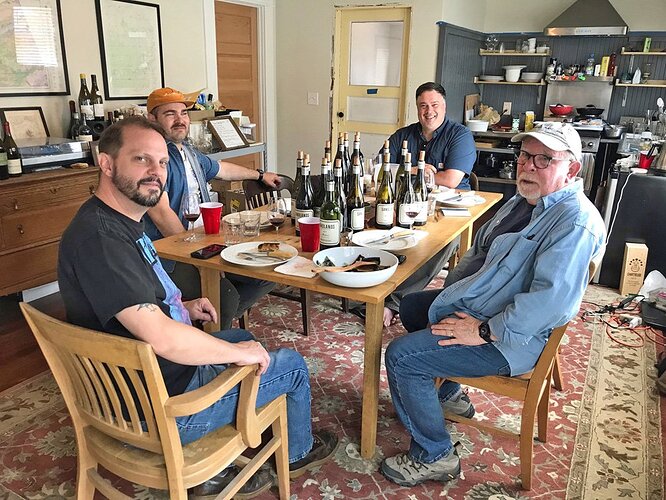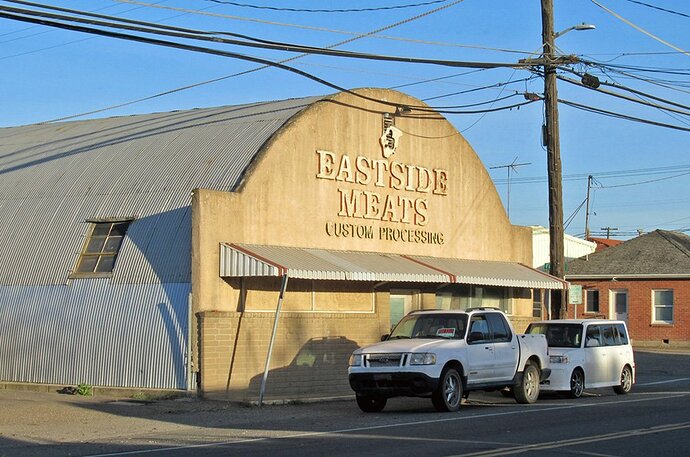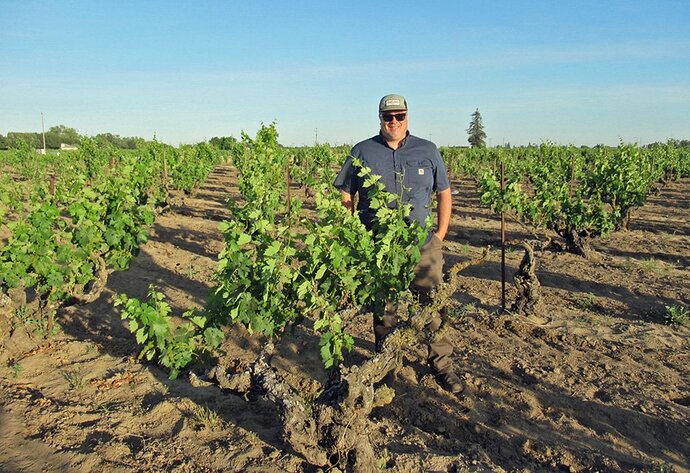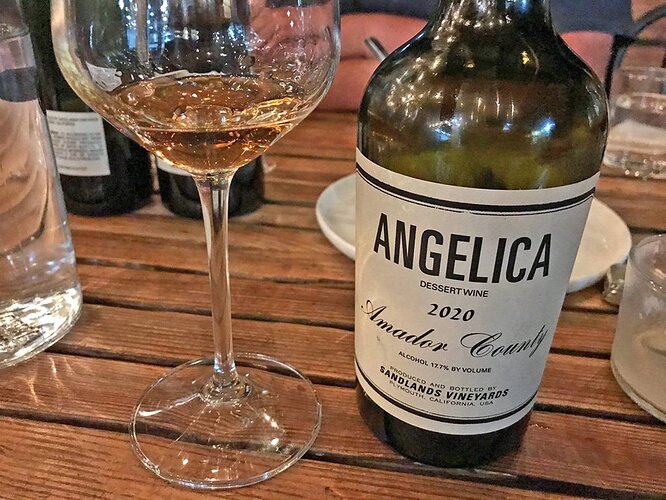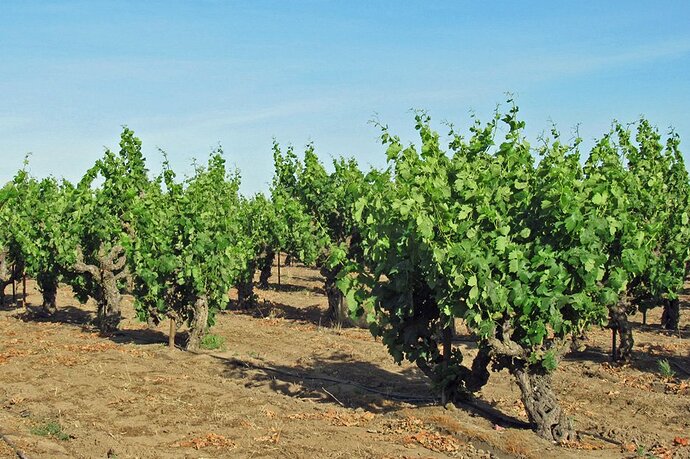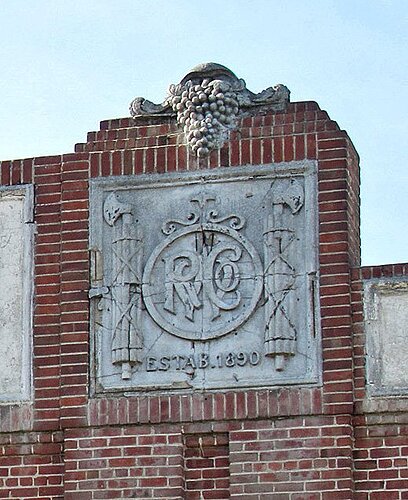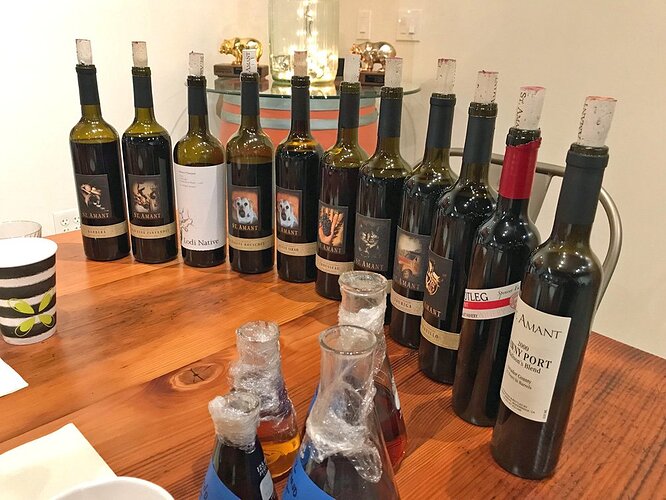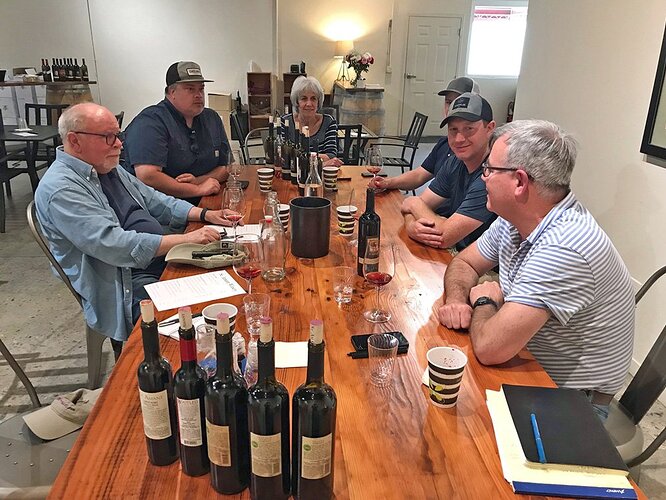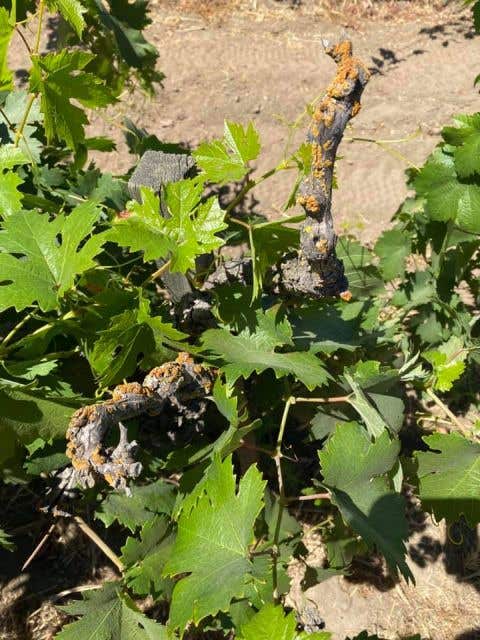Lodi and West Sacramento Wine Visits, May 2022, Part 1b - Sandlands / Turley + Vineyard Tour
I’ve posted a portion of Part 1 of a report on a three-day May wine tour with Eric Anderson of Grape-Nutz to visit vintners in Lodi and West Sacramento. Further parts will be following soon. The full version of this report is on the Grape-Nutz.com website:
Lodi and West Sacramento Wine Visits, May 2022 – Part 1
Fields Family Wines
Sandlands Vineyards / Turley Wine Cellars
St. Amant Winery
Lodi Vineyard Tour
Sandlands Vineyards / Turley Wine Cellars
Eric and I headed back on the road and over to the east side of Highway 99, and it wasn’t long before we arrived in the tiny town of Victor, where we were scheduled to meet vintner Tegan Passalacqua. I’d met him at a few tastings and have really enjoyed the wines I’ve tried from his Sandlands Vineyards label. We’d been in touch in early 2020 about my coming to visit him in Lodi, but that had to be put on hold – by this spring, I figured that I’d waited long enough and was able to arrange a visit for Eric and me. We turned up a small street in Victor and parked across from a modest house, walked over, and I knocked on the door. It wasn’t Tegan who opened the door, but Adam Saake, the winemaker for his own small label who Eric and I were scheduled to meet with a couple of days later – Eric and I learned from Adam that he’d worked with Tegan, which I hadn’t known. And once inside the house, Adam introduced us to Nick Guantone, the co-owner and head chef at Guantonio’s restaurant in Lodi. In addition to his winemaking, Adam is also a server there. Both Adam and Nick were there to join in for the tasting with Tegan. There will be more about both Adam and Guantonio’s later in this write-up.
Adam Saake, Nick Guantone, Tegan Passalacqua, Eric Anderson
Tegan had been in the back of the house but soon came out and welcomed us. He told us that he’s been renovating the home – slowly, as his busy schedule allows. As it was mid-day, he was cooking up some sausages for us from nearby Lockeford Meats and Sausage. Everyone there told Eric and me how good their sausages are (they were right!) and they noted that customers line up in the mornings to buy from the shop. As we proceeded to the table to sit down, Tegan showed us a couple of large soil maps on the living room wall of his house showing the Lodi region, and he pointed out some of the very unusual types of sandy loam soil found there. These soils are formed from eroded quartz and granite washed down from the Sierra Nevada by the Mokelumne River and deposited in the Lodi area. There’s also underlying limestone in some areas.
Tegan is originally from Napa Valley, and started in the wine industry as a lab technician there before joining Turley Wine Cellars in 2003. Tegan worked at Turley in both the vineyards and the cellar, and managed to find the time for additional experience working in New Zealand, in the northern Rhône Valley, and in Swartland, South Africa. He succeeded Ehren Jordan as the head winemaker and vineyard manager at Turley in 2013. Tegan and his wife Olivia (who also works in the wine business) and their two sons live in Napa Valley, though he’s often on the road in his role as vineyard manager, so the small house in Victor is well-located as a base for him to visit sites around Lodi and in Amador County. In all, Tegan manages the farming for about 100 acres of vineyards in the Lodi and Amador regions and another 100 acres in Napa and Sonoma.
In addition to Tegan’s work with Turley, he and Olivia have their own wine project, Sandlands. The label was launched with the 2010 vintage. The focus of Sandlands is on what might be called California heritage vineyards and grape varieties. Most of the vineyards Tegan sources from for Sandlands are older ones, some farmed by the same families for generations, and located in out-of-the-way wine regions that don’t generally garner a lot of acclaim. Many of these sites feature vines that are head-trained, own-rooted, and dry-farmed – things that were once the norm in California vineyards but are not often seen today. He works mainly with grape varieties that were once common in the state but lost popularity (and acreage) over the years, some of which are only now beginning to make a comeback. I should mention that he’s one of the founders of the non-profit Historic Vineyard Society, dedicated to identifying the many old vineyards of California and preserving them for the future.
One of these old, nearly-forgotten vineyards is one that Tegan purchased in 2012, and that he named Kirschenmann Vineyard for the longtime owners. It’s located not far from Victor, and has the Mokelumne River region’s characteristic deep sandy soil (good for own-rooted vines) and also has some limestone beneath it. Kirschenmann contains mostly own-rooted, head-trained, dry-farmed Zinfandel vines planted in 1915. Tegan has added small plantings of other varieties there in recent years, including Chenin Blanc and Cinsault. He told us that he’s recently purchased two properties near the town of Volcano in Amador County, and plans to plant vineyards there.
Tegan brought out the Lockeford sausages – three different kinds – and we all enjoyed them with salad plus green beans and some very nice crusty bread. As we all began to dig in to the food, we also started tasting over 20 wines Tegan had opened for us to try, mostly Sandlands 2019 bottlings plus a few Turley wines sourced from Lodi vineyards. He told us that he was excited about this tasting as he doesn’t often open such an array of his wines.
As Eric and I went through the wines with Tegan, Adam, and Nick, we learned about the wines and winemaking for Sandlands. Tegan said he plans to release 21 different bottlings from 2021 vintage, with about 3,000 cases total. The wines are currently made at the Turley facilities in both St. Helena and in Amador’s Shenandoah Valley, though Tegan bought a building in “downtown” Victor a few years ago that he plans to make into a winery for Sandlands. Basically an old corrugated steel Quonset hut with the “Eastside Meats” signage still on it, this is another project that’s moving along slowly for Tegan, and it sounds like it could still be awhile before the building is ready for use as the Sandlands winery.
Tegan does not inoculate for fermentations on the Sandlands wines, letting them ferment with native yeast. He also uses no new oak on these wines, and barrels range from three to seven years old. White wines are typically in barrel for about 15 months and around 11 months for reds. Whites are all whole-cluster pressed, and reds are fermented with whole clusters except for Zinfandel, which is destemmed. As we tasted through the wines, I asked Tegan why he uses an “e” at the end of Carignane when it seems like more and more vintners spell it without the “e” – he said that it’s the traditional spelling in California and he wants to remain true to that. The same is true with the “l” in Cinsault and it’s similar for his use of Mataro rather than Mourvèdre on the Sandlands labels.
Sandlands wines
We tasted a lot of wines with Tegan and moved through them pretty quickly, so my notes were a bit brief but hopefully enough to convey my impressions. We started with four white wines – three different Chenin Blancs and one blend that’s predominantly Chenin. Tegan gained a particular love of this grape variety while working in South Africa, one of the places that’s become particularly acclaimed for its Chenin Blancs. First was the 2019 Lodi Chenin Blanc, sourced from Kirschenmann Vineyard – this had stone fruit and pear aromas with stony mineral notes, a juicy texture on the palate, and a long finish. We followed this with the 2019 California White Table Wine, which is 67% Lodi Chenin Blanc and 33% Napa Sémillon. This showed more of a citrus character with a touch of honey, a bit bigger mouthfeel, with nice texture on the finish. Two more varietal Chenins followed – the 2019 Amador County Chenin Blanc came from head-trained, dry-farmed vines at Story Vineyard, and displayed pear and citrus notes, medium weight with fine acidity, and a chalky mineral character on the finish. The 2019 Napa Valley Chenin Blanc, from old vines at Casa Nuestra Vineyard near St. Helena, featured bright stone fruit aromas with stony mineral undertones, a broader yet still lively texture, and long finish.
Three lighter red wines were next, starting with the 2019 Amador County Mission from vines planted in the 1850s at Deaver Ranch, probably the oldest surviving commercial winegrape vines in California. I always have a hard time conveying the very distinctive Mission character, but this wine showed it perfectly, with red fruit, spice, earth, and fresh herbs, and more grip on the finish than you’d expect from such a light red wine. The 2019 Lodi Cinsault came from Cinsault vines at Bechthold Vineyard dating from 1886, the oldest in the country if not the world – bright red fruit, spice, and floral notes, with a juicy texture and vibrant finish. Fruit for the 2019 Sonoma County Trousseau was sourced from Bohan Vineyard on the West Sonoma Coast, at 1,600-foot elevation less than two miles from the ocean. This had a very light color, with a savory herbal nose along with spice, red fruit, and a touch of pepper, with a moderately tannic finish.
Four Carignanes and Carignane blends followed. The 2019 Lodi Carignane came from vines planted around 1900 by Joseph Spenker, one of Lodi’s iconic early winegrape growers – upfront dark berry fruit, with spice, earth, and black pepper in support, medium-bodied with a long finish. Next was the 2019 Contra Costa County Carignane, from 1920s vines at Del Barba Vineyard, another fruit-forward wine with bright and spicy plummy fruit with pepper undertones, bigger texture and firmer tannins. The 2019 Lodi Red Table Wine is a blend of 1/3 each Bechthold Cinsault, Spenker Carignane, Kirschenmann Zinfandel – this featured floral red and black fruits aromas, dried herbs, and a vibrant mouthfeel and finish. Another red blend, the 2019 Contra Costa County Red Table Wine is 65% Carignane and 35% Mataro. More fruit-forward than the previous wine, it had plenty of savory herbal character along with earth, olives, and plummy fruit, fine acidity and a lively finish.
The wines just kept coming! Tegan had us taste the 2019 Santa Clara County Grenache next, from Besson Vineyard, planted in 1910 – bright red berry fruit along with earth and floral notes, medium weight with moderately tannins. The 2019 Lodi Zinfandel, from Kirschenmann Vineyard, includes a little Carignane and Cinsault. This had intense raspberry and boysenberry aromas with earth, flowers, and dried herbs in support, good structure and fine tannins. We compared Mataro from own-rooted, head trained, dry-farmed vines grown in two different regions. The 1922 vines at Del Barba Vineyard were the source of the 2019 Contra Costa County Mataro – it displayed bright black cherry and plum fruit and earth aromas, with a lively texture and moderate tannins. We followed that with the 2019 San Benito County Mataro, from vines planted in 1923 at Enz Vineyard. Showing a deeper and darker fruit profile with iron, earth, and spice notes, this had a fuller and more structured mouthfeel and grippier tannic finish.
Tegan Passalacqua at Kirschenmann Vineyard
We had two more Sandlands wines at the afternoon tasting, a couple of Syrahs. The 2019 Santa Lucia Highlands Syrah was from Soberanes Vineyard – herbal and floral plum and darker fruit plus undertones of pepper and spice, with plenty of structure and grip. The 2020 Santa Barbara County Syrah is the first bottling of this wine for Sandlands. From Bien Nacido Vineyard, it’s 75% X Block and 25% Z Block fruit, and it was fermented entirely with whole clusters. Darker color than the previous Syrah, with dark berry fruit, spice, and iron with gamy and herbal notes, full mouthfeel with big but fine tannins on the finish.
I also need to mention one additional wine that Tegan opened for Eric and me that evening when we had dinner together at Guantonio’s – the 2020 Angelica. Made with fruit from the 1850s Mission vines at Deaver Ranch in Shenandoah Valley, the grapes were pressed right away and did not spend time on skins, and the wine was fortified to about 18% alcohol. Angelica may be the oldest style of wine made in California, dating back 200 years or more. It was a lighter style of Angelica than some that I’ve tried, and although I didn’t take any notes on this one, I certainly recall that I enjoyed it!
Turley wines
But wait, we were not yet finished with the afternoon tasting! Tegan brought out four Turley wines for us to try, all from Lodi fruit. As with the Sandlands wines, these were all fermented with native yeast. Tegan noted that the Turley reds are typically bottled a little earlier than Sandlands, and comparing the wines from the two labels, the Turley wines tend to be the bigger and riper of the two. The Turley 2019 Bechthold Vineyard Cinsault was fermented with whole clusters and aged in older French oak. It featured red cherry fruit, herbs, and floral notes, medium-bodied with a pleasant texture and slightly chalky tannins on the finish. The Turley 2019 Kirschenmann Vineyard Zinfandel came from three separate picks at the vineyard, and the wine was aged in 20% new oak. Bright and intense black cherry fruit, dried herb, spice, and a touch of oak in the background, with fine structure and moderate tannins.
Next was the Turley 2019 Steacy Ranch Zinfandel. From a site right next to Kirschenmann, this has eight acres planted in 1907 and includes a little Grenache, Syrah, and Mission in vineyard that also went into this wine. This displayed a darker fruit profile than the previous two Zins plus a bigger spice component, fuller body, and more grip on the finish. We finished the afternoon tasting with Tegan with the Turley 2019 Dogtown Vineyard Zinfandel – from the Clements Hills AVA in the eastern part of Lodi, the own-rooted, dry-farmed vines there were planted in 1944. Lots of spice along with ripe red fruit, earth, dried herbs, and undertones of oak, with great texture and fine tannins.
With that, we were done with our tasting of Sandlands and Turley wines with Tegan, Adam, and Nick. Tegan had arranged for us to stop in at St. Amant Winery afterwards, so Eric and I hopped back in my car and drove to St. Amant, not far away. After cleaning up a bit from lunch, Tegan joined us there a few minutes later, though Adam and Nick had to head to Guantonio’s to get ready to open for dinner at the restaurant.
Wow, this was quite an experience! An informal tasting of so many wines – plus a delicious lunch – with a fun group of people. It was great to meet Adam and Nick, and Tegan was super-generous to open all those bottles for us – they ranged from really good to outstanding. Picking highlights from such a strong bunch of wines was tough, but my favorites among the Sandlands wines included the 2019 Amador County Chenin Blanc, 2019 Napa Valley Chenin Blanc, 2019 Amador County Mission, 2019 Lodi Cinsault, 2019 Lodi Red Table Wine, 2019 Lodi Zinfandel, 2019 San Benito County Mataro, and 2020 Santa Barbara County Syrah. Among the Turley wines, I thought the 2019 Bechthold Vineyard Cinsault and 2019 Kirschenmann Vineyard Zinfandel were particular standouts. Tegan is doing a remarkable job in both the vineyard and the winery, and he’s got to be among the top vintners in California right now. I know that both Eric and I felt privileged that we were able to take part in this rare and memorable tasting.
Lodi Vineyard Tour
After we’d finished our visit to St. Amant Winery, Eric and I returned to Tegan’s house in Victor to meet him there again. He’d told us that he would give us a tour of some of the older Lodi vineyards in his pickup truck, and we were looking forward to that. Tegan had gotten back a few minutes earlier and was clearing out enough space in the cab for Eric and me to sit in his truck – like many people, he uses it as his mobile office so there was a lot of stuff inside. After a few minutes we climbed into the truck, and away we went. Much like our tasting with Tegan earlier that afternoon, the tour of vineyards was fast-paced but lots of fun.
Tegan knows the Lodi area’s vineyards as well as anyone, and he’s extremely knowledgeable about their history and of course about the vines and the soil. My notes during this fascinating tour are almost non-existent, as it’s not easy to write notes in a moving truck on dirt roads! I’m not sure whether the list of vineyards below is in the correct order of our quick drive-by visits though I think it’s at least fairly close. Bechthold and Kirschenmann were the only two vineyards where we stopped to get out and take a closer look.
Bechthold Vineyard
A number of the old vineyards we saw are located within a large oxbow of the Mokelumne River that’s just north of Victor. Of the portions of the Lodi wine region that we saw on this brief tour, it has the deepest, sandiest soil. The soil at Kirschenmann definitely had a lighter and more chalky appearance than other vineyards we saw. Tegan drove us north into the Borden Ranch AVA, where I’d never been before. A hilly area like Clements Hills just to the south, Borden Ranch has much different soil from any other part of Lodi that I’d seen – more volcanic in origin, it’s noticeably redder and stonier. We ultimately got out into the Clements Hills AVA near the town of Lockeford, and then back to Tegan’s house.
Here are vineyards I noted that we saw while riding with Tegan – I may well be missing a couple of others. All are in the Mokelumne River AVA unless otherwise indicated, with the original year of planting indicated.
Schmiedt Ranch – Zinfandel planted 1918
Bechthold Vineyard – Cinsault planted 1886
Rauser Ranch – Carignane planted 1906 and Zin from mid-1910s
Stampede Vineyard – Zinfandel planted late 1920s
Vista Luna Vineyard – Iberian and other varieties, Borden Ranch AVA, planted 2008
Mokelumne Glen Vineyard – German and Austrian varieties planted mid-1990s
Bokisch Las Cerezas Vineyard – Spanish varieties, planted 1999
Kirschenmann Vineyard – Zinfandel planted 1915
Spenker Vineyard – Carignane planted around 1900
Dogtown Vineyard – Zinfandel planted 1944, Clements Hills AVA
One more thing of note that Tegan pointed out to Eric and me was the pre-prohibition brick building with grape-themed terra-cotta ornamentation near Victor that was once one of the Roma Wines facilities. Said to be the largest winery in the country by the 1940s, Roma had a dozen production facilities in California. The brand faded and was sold around 1970 but it had quite a heyday!
Old Roma Wines facility
What a great time – as if our marathon tasting at Tegan’s house and our visit with Stuart at St. Amant earlier that afternoon weren’t enough, this was the icing on the cake, a memorable tour of some of Lodi’s most historic vineyards. Seeing so many beautiful old vines – plus a few more highly-regarded recent plantings – with a tour guide as knowledgeable and entertaining as Tegan was certainly one of the highlights of our wine trip.
